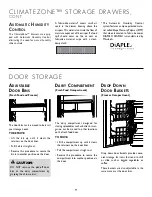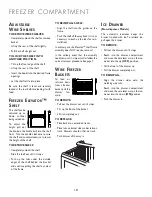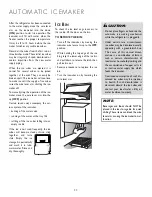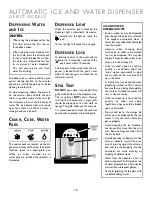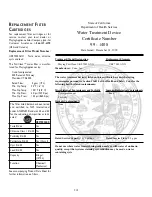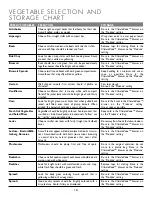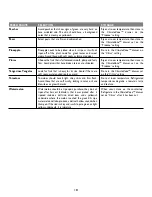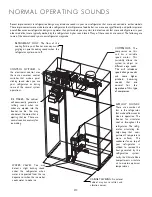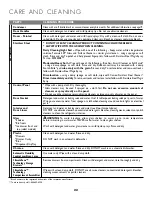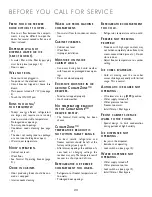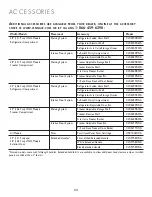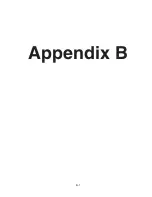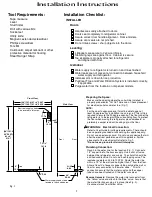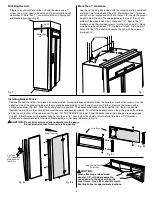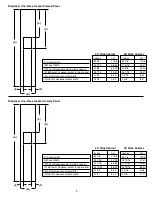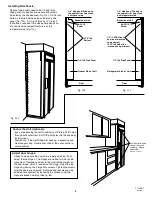
23
F
RESH FOOD OR FREEZER
DOOR DIFFICULT TO OPEN
.
• Due to air flow between the compart-
ments, it may be difficult to open the
doors for several seconds after one of
them is closed.
D
ISPENSER WILL NOT
DISPENSE WATER OR ICE
(
SELECT MODELS
).
• A water filter, or the filter bypass plug
must be in place (see page 13).
• Door is open.
W
ILL NOT RUN
.
• Power cord not plugged in.
• No power at the electrical outlet.
• Circuit breaker tripped or house fuse
blown.
• Main power turned off (“O”) (see page
4).
• Touch the ON/OFF pad.
R
UNS TOO LONG
/
TOO FREQUENTLY
.
• Today’s energy efficient refrigerators
are larger and require more running
time to maintain stable temperatures.
• Prolonged door openings.
• Too many door openings.
• Condenser needs cleaning (see page
19).
• The door not sealing (due to a package
or a container holding door open).
• Warm room temperature.
N
OISY OPERATION
.
• Cabinet not level.
• Weak floor.
• See Normal Operating Sounds (page
21).
O
DOR IN CABINET
.
• Odor producing foods should be cov-
ered or wrapped.
• Interior needs cleaning.
W
ARM AIR FROM MACHINE
COMPARTMENT
.
• Normal air flow for condenser circula-
tion.
C
ABINET VIBRATES
.
• Cabinet not level.
• Weak floor.
• Improper installation.
M
OISTURE ON INSIDE
CABINET WALLS
.
• Can occur during hot, humid weather
with frequent or prolonged door open-
ings.
• Door not closed properly.
E
XCESSIVE MOISTURE IN OR
AROUND
C
LIMATE
Z
ONE
™
DRAWERS
.
• Food not wrapped properly.
• Hot, humid weather.
N
O TEMPERATURE READOUT
IN THE
C
LIMATE
Z
ONE
™
DRAWER DISPLAY
.
• The Normal Cold setting has been
chosen.
C
LIMATE
Z
ONE
™
TEMPERATURE READOUT IS
NOT WITHIN TARGET RANGE
.
• For best results, refrigerator and
freezer controls should be left at the
factory settings (see page 5).
• After drawer openings, the addition of a
new load or changing settings, the
readout may vary.The temperature will
recover in a short period of time.
R
EFRIGERATOR OR FREEZER
COMPARTMENT TOO WARM
.
• Refrigerator or freezer temperature set
too warm.
• Prolonged door openings.
R
EFRIGERATOR COMPARTMENT
TOO COLD
.
• Refrigerator temperature set too cold.
F
REEZER NOT FREEZING
PROPERLY
.
• Products with high sugar content may
not harden completely when frozen (ice
cream, concentrated juice, etc.) Do not
store in door.
• Adjust freezer temperature to a colder
setting.
I
CE CUBES EVAPORATE
.
• Cold air moving over the ice cubes
causes shrinkage, especially with limited
usage. This is normal.
A
UTOMATIC ICE MAKER NOT
OPERATING
.
• Wire lever arm in up
(OFF)
position.
• Water supply turned off.
• Water pressure too low.
• Freezer too warm.
• Install filter or filter bypass.
F
RONT CABINET SURFACE
WARM TO THE TOUCH
.
• Special design to limit condensation
during periods of high humidity.
I
CE DISPENSER NOT
OPERATING
.
• Ice jam in the dispenser.
• Icemaker not operating.
• Lock switch on (see page 12).
W
ATER DISPENSER NOT
OPERATING
.
• Water supply turned off.
• Water pressure too low.
• Lock switch on (see page 12).
• Install filter or filter bypass.
B E F O R E Y O U C A L L F O R S E R V I C E

